Le séminaire de Gabriel Tobie aura lieu en salle Jean Jung le mardi 23 juin 2015 à 14h.
Titre : Cryovolcanic exchange processes on icy moons
Abstract:
The Galileo mission (1995-2003) and the Cassini-Huygens mission (2004-2017) in orbit around Jupiter and Saturn, respectively, have revealed that these two giant planets host several very active moons. One of the most spectacular discovery is certainly the observation of active jets of water vapor and icy particles above Enceladus’ south pole, which demonstrates how active icy moons can be. Many surface features, possibly of cryovolcanic origin, have also been identified on the surface of Europa, Ganymede, Titan, Triton and other moons. On Europa, the discovery of hydrated salts on its surface support the idea that exchanges between the internal ocean and the icy crust have occurred along Europa’s history and is probably still occurring. A recent detection of a vapour plume over Europa’s south pole supports the idea of ongoing activity on Europa. On Titan, the measurements performed by the Huygens mass spectrometer provided circumstantial evidences that the atmospheric methane is recycled by internal outgassing processes associated to cryovolcanic activity, maybe still operating. On Enceladus, there is now no doubt that cryovolcanic activity, anticipated since the Voyager era, is occurring and sampling of the water plumes provide a unique opportunity to probe the composition of its subsurface.
Even though there are more and more evidences for cryovolcanic activity on icy moons, the internal processes leading to such an activity still remains poorly constrained. Cryovolcanic flows and edifices are probably related to the generation of melt at shallow depths and/or the rise of aqueous solutions through the icy crust, but the heat sources, the internal dynamics, and the extraction processes required to trigger a cryovolcanic event still need to be understood. Various mechanisms have been proposed for the melt generation and their transport to the surface. Tidal friction and the crystallization/melting of internal oceans probably play a key role. The presence of salts, ammonia hydrates, clathrates probably help the cryomagma generation and their ascent. In this talk, I will present the different mechanisms that could lead to cryovolcanic activity, and I will discuss their likelihood for each main icy moon.


